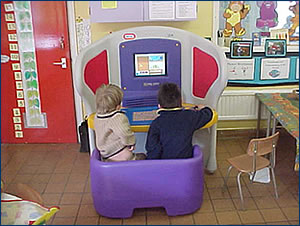
Planning and Development
Early Years and ICT
"We live in a rapidly changing technological world where technologies are extending human capacities. We therefore need to prepare pupils to understand, experience and make an active contribution to learn, communicate and develop the appropriate skills.
The development of these skills needs to start at an early age. To achieve this we must promote the skills of early years teachers so as to enable them to develop effective policies and appropriate teaching strategies which exploit the potential computers and other technology tools."
IBM KidSmart Early Learning Programme
UK Evaluation Report Phase 1 (2001-2002)

ICT in Early Years Settings
"Children can use any resource, which may include ICT, to promote their learning in at least two different ways. They can learn about a resource, and then use this knowledge to learn with it.
Learning about ICT involves developing children’s understanding of the uses of information and communications technologies and associated terminology by encouraging them to observe and talk about the use of ICT in the environment.
Examples of this include learning how to:
- programme a Robotic toy
- use a mouse
- use a digital camera
- switch on a cassette player
- navigate or move between different areas in computer programs
Learning with and through ICT can support and promote other learning. Examples of this include:
- using digital camera to record what happens when seeds are planted
- working out how to park a programmable toy truck
- watching a video to find out about festivals and celebrations
- listening to a tape recording to identify different sound effects."
Early Learning Forward Thinking Reference Pack
Learning and Teaching Scotland 2003
In order to use ICT effectively practitioners need to ensure that it is applied appropriately through all curriculum areas and through all areas of the learning environment. Children should be able to access resources independently, in a variety of groupings and during adult or child led activities.
Children’s understanding of technology can be extended through role play. There are many resources available to enhance their play and understanding such as toy microwaves, washing machines, swipe tills, and mobile phones which can be incorporated into role play areas.
It is important that adults model everyday use of ICT children for example a visit to the school secretary. When planning for the use of ICT with young children, the following can be considered:
Room Layout
ICT resources are most effective to children’s learning when they are used throughout the early years setting and not in a separate "technology area" or ICT suites.
When positioning computers and interactive whiteboards it is essential that careful thought is given to issues such as source of light and health and safety issues. Ideally access to power points should be possible throughout the learning environment. If that is not possible lap top computers enable easier integration.
Children Playing Together
Wherever possible, ICT resources should be accessible to children, offering opportunities for them to learn from each other as well as independently. In order to facilitate this, seating arrangements, resources and use of space need careful thought and planning.
Observing and Recording
In order for children to make progress in their learning, staff should observe, monitor and record children’s activity and interactions.
Health and Safety
Care should be taken when setting up ICT resources to ensure that health and safety issues are addressed such as, appropriate height of monitors and seating and avoiding trailing leads etc.
For more information see:
| ICT in Practice Awards: Innovation and Change Windows Media Video (5.5 Mb) |








